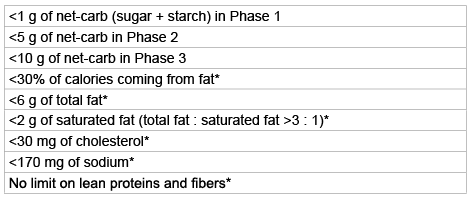
Table 1: Limits of the macronutritients (per serving) in Dr. Poon’s Metabolic
Diet program
*The same criteria applied to all three phases

Pat Poon*
Director of the Dr. Poon’s Metabolic Diet Clinic, Toronto, Canada*Corresponding author: Pat Poon, Director of the Dr. Poon’s Metabolic Diet Clinic, Toronto, Canada, Tel: 416-461-4443; Fax: 416-461-4777; E-mail: doctor@poondiet.com
A diet program was designed to treat obese patients with medical problems associated with their weight. This study was done to assess the success rate of the diet. A total of 384 overweight and obese patients were admitted to the diet program from January 2014 and their progress was followed for a period of 18 months. 62% of the admitted patients were able to lose 10% of their weight. The average amount of time to reach the 10% weight loss was 10 weeks. Among the patients who were able to lose 10% of their weight, 78% of them were able to lose additional weight, or maintained the 10% weight loss for up to 18 months, which was the length of the study. About 8% of the patients were able to achieve the normal BMI of 25. This result is very encouraging and the study is still ongoing, which will add more power to this study.
Metabolic diet; Obese patients; Metabolic syndrome
Dr. Poon’s Metabolic Diet Program (DPMDP) was set up to counsel patients who are suffering from obesity related diseases. The program is particularly interested in treating Metabolic Syndrome (MS), since the morbidity of MS is related to the patient’s weight. According to the International Diabetic Federation, obesity (BMI of over 30) is a prerequisite for the development of MS [1]; hence, helping the patient lose weight will be a good way to treat, or prevent, the co-morbidity of MS. There is currently no set of strict guidelines with which to measure the success rate of a diet program. A successful diet program should be one that is able to help the patients lose a significant amount of weight, and maintain the weight loss over time. It should be a permanent lifestyle change, not a quick fix. The diet should improve the patient’s medical condition as the patient loses weight. No one has yet found the perfect diet, and all diets are difficult to do. Most doctors and dietitians believe that eating a “healthy, balanced diet” with less fat, such as described in the Canada Food Guide, in addition to staying active, are the keys of a successful weight loss diet. It sounds easy enough, but then why is it that the obesity rate is on the rise in North America? The Canada Food Guide states that their dietary recommendation is not designed to treat any chronic medical conditions; their guidelines are for the prevention of obesity, but not a suitable diet to treat obesity and its co-morbidity [2].
Of all the existing commercial diet programs, the Weight Watcher’s (WW) diet is rated as one of the best. The Weight Watcher’s diet program is an example of a calorie counting diet [3]. No food is off-limits, but you have to eat within a set limit of points (calories). One study showed that clients on the WW plan lost an average of 11 lbs in one year, while the group that was solely under their doctor’s care only lost 5 lbs [4]. Another study demonstrated that clients of the WW program lost 5% (10 lbs) of their initial weight in six months, and kept half of that weight loss (5 lbs) after two years [5]. This amount of weight reduction is very small compared to the total weight that an obese MS patient should lose, in order to improve their health. Furthermore, should regaining 50% of the lost weight within 1 to 2 years be considered good, or normal, for a diet program? Should diet programs use the results of the WW program as a yardstick to measure the success of their own programs? That is, should a diet program that helps their patients lose 5% of the initial weight in six months or 11 lbs in one year, and is able to maintain 50% of the patient’s initial weight loss after two years, be considered a good program?
Physicians familiar with obesity-related diseases believe that a 10% weight reduction makes an impact on the patient’s health [6-8]. They also believe that the diet should be a lifestyle modification, and that the patient should be able to keep the weight loss, and diet, for life, because the medical conditions which improved after the initial successful weight reduction, will deteriorate when the patient regains their weight.
The benefits of the DPMDP on obesity-related medical conditions were previously reported [9]. In that study, 100 patients with MS were admitted to DPMDP. Blood work was done by the referring physician, and was repeated once the patient lost 10% of their initial weight. Fasting blood glucose decreased by 24.7% (from 7.7 to 5.8 mmol/L); A1C decreased by 19.7% (from 7.1 to 5.7%); triglycerides decreased by 42% (from 1.80 to 1.05 mmol/L); total cholesterol decreased by 14.8% (from 5.35 to 4.56 mmol/L); there was no change in HDL (1.26 mmol/L) but the total cholesterol/HDL ratio decreased by 21.6% (4.37 to 3.47). All parameters of MS improved with a 10% weight reduction on the DPMDP.
The objective of this pilot study is to assess the effectiveness of the DPMDP on weight loss and maintenance.
By referral from their family doctor or specialist, a total of 384 new patients from January 15, 2014 to February 14, 2014 were admitted to the DPMDP at one of four clinic locations. Patients who did not start the DPMDP, did not qualify, or did not return to the DPMDP for their initial bi-weekly follow up assessment, were excluded from this study. Patients who did not have any medical problems related to their weight, patients with type 1 diabetes, and patients with end stage liver or renal failure were all excluded from the DPMDP. All accepted patients were either obese with a Body Mass Index (BMI) of over 30 (90.6%) or overweight with a BMI of over 25 (9.4%), and suffered from weight related medical issues such as hypertension, diabetes or dyslipidemia. The patients’ weight was monitored for a period of 18 months, or until the patient dropped out from the program. Their diet consisted of 3 phases, and was not a “howmuch-to-eat” but a “what-to-eat” type of diet plan. It also did not require the patients to count calories, or measure the amount of food consumed. Patients were told to eat until full using a set of dietary guidelines, and the patients could eat the allowed food items at any time of the day. The main objective of the diet was to consume mostly proteins (for the essential amino acids), good fats (for the essential fatty acids), and high fiber vegetables, while limiting the consumption of sugar, starch, saturated fat, trans fat, and sodium (Table 1). In the ideal scenario, the patients should have been losing fat and excess water, while preserving the lean muscle mass. Phase One of the DPMDP had the least amount of sugar and starch allowed, while small amounts of sugar and starch were reintroduced when the patient progressed to Phase Two and Phase Three of the DPMDP. Phase One consisted of all the essential nutrients that a human needs for good health. There was no maximum limit for how long the patients remained on Phase One; however, a minimum of two weeks on Phase One was required. Carbohydrates and other foods were re-introduced to the diet for patient enjoyment and craving satisfaction, but not for the nutritional benefits, when the patient progressed to Phase Two (also known as the “Continued Weight Reduction Phase”) and Phase Three. Patients were expected to lose 10% of the weight within 8-10 weeks. If the patient went off the diet plan, or did not achieving the weight loss goal within the 8-10 week time frame, the patient was put back on the Phase One diet until their weight loss was back on track. Patients were allowed to go on the maintenance part (Phase Three) of the DPMDP when they went on holidays or business trips, even before they reached their weight (BMI 25) and body fat percentage goals. The DPMDP also offered a vegetarian version of the diet plan, which had higher carbohydrate content than the regular diet plan. Other than the diet plan, the patients also received instruction and counseling on exercise, label reading, human nutrition, supplements and stress eating. Patients were encouraged to join a patientrun self-help group on social media sites such as Facebook (Dr. Poon’s Metabolic Diet Support Group), as well as in patient-run local support group meetings. Patients initially returned to the clinic for assessment by a physician every two weeks, and then less frequently as the patient progressed through the diet program. Laboratory tests were ordered, if warranted, when the patients lost more than 10% of their initial weight. The patients were expected to lose 7 to 10 pounds in the initial two weeks, and 10% of their weight every eight weeks. The program utilized the Tanita Body Composition Analyzer TBF-310 to assess the patient’s weight, fat mass, and water weight at each visit [10]. All data was electronically recorded. There was no follow-up with the patients who quit the DPMDP. Statistical analysis was performed using the Microsoft Excel program.

Table 1: Limits of the macronutritients (per serving) in Dr. Poon’s Metabolic
Diet program
*The same criteria applied to all three phases
The total number of patients was 384, with 90 males (23.5%) and 294 females (76.5%), and an average age of 47.7 (range of 16-79 years old). The median age was 48.0. 100% of the 384 patients were on other diet programs before being referred to the DPMDP. The average weight of the patients before starting the DPMDP was 173.48 lbs (129.6 lbs to 238.8 lbs), with an average BMI of 36.69. There were 240 patients (62%) who achieved a weight loss of 10% of their original weight, and they mostly achieved this goal within 8-12 weeks (Figure 1). 189 of the 240 patients (79%) who lost 10% of their weight were able to maintain that 10% weight loss while still on the DPMDP. The average weight after the diet was 147.99 lbs (118.5 lbs to 183.0 lbs) and an average BMI of 33.07 (Figure 2). Two-tailed Student T-Test has a p value of <0.0001.
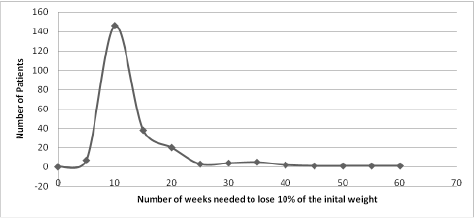
Figure 1: The amount of time needed to archived 10% weight reduction
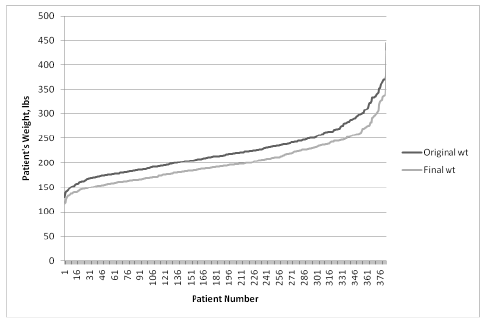
Figure 2: Patient’s weight before and after the diet program.
A total of 90.6% of the patients were classified as obese at the outset, with only 66.7% of the patients remaining in the obesity category while on the DPMDP (Table 2).
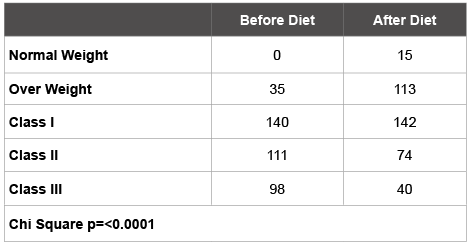
Table 2: The number of patients in each of the weight category
Out of the 384 patients, 79 patients continued to attend the diet program after 18 months, resulting in a retention rate of 20.5% (Figure 3).
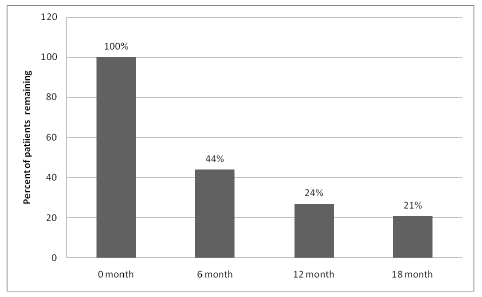
Figure 3: Retention Rate of Dr. Poon’s Diet Program
After 1 year, 24% of the initial patients were still on the DPMDP. The average weight reduction after 1 year was 30.1 lbs, which is a 13.2% average weight reduction. 38 patients (7.8%) achieved the normal BMI of 25 within 18 months.
There were no incidents of diet-related complications that led to discontinuation of the diet program.
The initial result is very encouraging. 62% of the patients who tried the diet were able to lose 10% of their initial weight, mostly within 24 weeks, and 79% of them were able to maintain the 10% weight loss while on the diet. There is no diet that can guarantee a 100% success rate over time. The WW diet was suggested as an example of a reasonable commercial diet, but most of the patients who adhered to the WW diet only lost 5% of the initial weight after 6 months, and clients regained half of the lost weight after 2 years. This study demonstrated that DPMDP has a favorable result compared to the WW diet. At the end of 1 year, the average weight reduction for the DPMDP was 30 lbs, compared to 11 lbs with the WW diet. The percent weight reduction after 1 year was also better with the DPMDP.
There are some advantages of the DPMDP compared to commercial diet programs. The patients are always assessed by a medical doctor, rather than by laypersons, nurses or dietitians. Also, not all diet programs are suitable for patients with complicated medical problems; these patients require close monitoring by medical doctors. Medications may also need to be adjusted as the patients lose weight. The DPMDP is free to patients who qualify, and does not charge the patients any out-of-pocket fees, compared to the paid diet programs which can be very expensive. Patients are expected to purchase fresh foods from their neighborhood grocery store, and there is no need to purchase expensive prepared meals. If patients wish to purchase snacks or supplementary items from health food stores, they may do so on their own volition. Free group counseling sessions on label reading are given to patients on a regular basis, so that they can identify healthier products at the grocery and health food stores. Exercise counseling is also an important part of this program, in order to help patients improve their cardiovascular fitness, and to maintain or gain lean muscle mass. There is no need to count calories or measure the weight of foods on the DPMDP; hence, the patients should never complain about feeling hungry. Patients are told to eat until they felt full, and are allowed to eat at any time of the day. Since this is a diet that contains all the essential human nutrients and does not restrict calories, nutritional supplements are usually not needed.
There are pros and cons about the DPMDP, and in general, there are multiple reasons why patients do not stick to diet programs. In our experience, carbohydrate craving is the main issue in our program. Studies have shown that carbohydrate addiction is a true medical condition involving the cannibinoid receptors in the basal ganglia. Another reason for failure is because fresh and healthy foods are more expensive than junk foods. Even though our diet program is free to the patients who are in need, some low income patients have difficulty purchasing good quality protein and fresh produce. The less expensive foods tend to be high in fat, sugar and/or salt. Human tradition can also be a road block to our diet program, as every culture has their own set of holidays and celebrations. Food is usually a big part of these celebrations, and most of them involve sweets. If you are a member of a big family, there will be birthday, holiday and anniversary celebrations on a regular basis, where cake or other off diet foods are often traditionally served. There are too many temptations out there for some patients. We found that patients who rely on storebought foods because they do not cook, or patients who travel often, also have difficulty with dieting. Stress eating is another big issue; thus we offer special counseling sessions on stress management when needed. Shift workers and patients suffering from sleep deprivation also found it difficult to follow a low-carbohydrate diet. These patients tend to not do much exercise as well.
This pilot study demonstrated that most of the patients were able to lose 10% of their weight within a short period of time, and many of them were able to keep the weight off for at least 18 months, the length of the study. No major side effects were reported.
The total number of subjects of this study is small, but as we continue to monitor the success of this diet program, more patients will be add to the study. The length of time of this study is currently 18 months, but we will continue to monitor all the patients who are still participating in the DPMDP, so that we will have long-term data available in the future. Although we encouraged the patients to exercise, and exercise recommendations were given to the patients, we did not monitor the amount of exercise that each individual was doing, and thus were unable to correlate that to the amount of overall weight reduction.
Download Provisional PDF Here
Article Type: Research Article
Citation: Poon P (2015) A Pilot Project to Assess the Success Rate of Dr. Poon’s Metabolic Diet Program. Obes Open Access 2(1): doi http://dx.doi.org/10.16966/2380- 5528.114
Copyright: © 2015 Poon P. This is an open-access article distributed under the terms of the Creative Commons Attribution License, which permits unrestricted use, distribution, and reproduction in any medium, provided the original author and source are credited.
Publication history:
All Sci Forschen Journals are Open Access